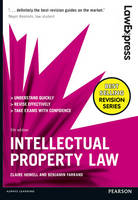Intellectual Property Law Books

Intellectual property (IP) refers to creations of the mind. This applies to a range of fields including artistic works, literature, music, architectural design and inventions. It also encompasses designs, names, images and symbols that are used commercially or in other spheres.

Buy Intellectual Property Law 3 by Lionel Bently, Brad Sherman (ISBN: 042) from Amazon's Book Store. Everyday low prices and free delivery on eligible orders. Bently and Sherman's Intellectual Property Law is the definitive textbook on intellectual property law.The book's all-embracing approach not only clearly sets out the.
The term intellectual property first came into being in the 19th century, but only became commonly used towards the end of the 20th century. The World Intellectual Property Organization (WIPO) was founded in 1967 as a specialized agency of the United Nations with its headquarters in Geneva, Switzerland. WIPO is mandated with ensuring that an international system of IP is established to safeguard and protect creativity in a balanced and appropriate manner. In June 2000, the Policy Advisory Commission (PAC) of the World Intellectual Property Organization (WIPO), namely WIPO-PAC, met in Geneva to define and refine policy related to intellectual property. The idea of intellectual property came into being as early as 1883. Concern had been raised a few years earlier, when a group of creators would not participate in the International Exhibition of Inventions in Vienna for fear of their ideas being stolen. The 1883 Paris Convention for the Protection of Industrial Property marked the first major treaty to be signed regarding intellectual property protection.

This accord pertained particularly to protection of IP between countries. These industrial property rights patents, trademarks and industrial designs. The treaty paved the way for organizations such as WIPO. The changing face of the world today has precipitated a growing need to address the subject. Intellectual Property falls broadly into two categories: industrial property and copyright. Industrial property includes laws relating to patented inventions, trademarks and designs. Literary and artistic works fall under copyright law.
These works may include poetry, drama, dance, novels, music, films, paintings, photographs, and other fine art and designs. Artists and their performances are included in copyright issues, whether this pertains to stage, screen, recordings, broadcasts or media programs. The notion of who controls knowledge, or the property of the mind, has manifested in the concept of intellectual property. This has become increasingly challenging in the information age and the era of the worldwide web, as the proliferation of knowledge abounds. Determining the source of knowledge and ownership can be problematic.
WIPO has drawn a picture of the 21st century as a time of knowledge-based economies, with intellectual property a crucial aspect of this. The aim of WIPO is to ensure that creative potential is encouraged, while at the same time protecting the ownership of such knowledge. The attention given to IP has raised awareness of the significance of intellectual property ownership of individual creators. The intellectual ideas, innovations and creations of the mind are acknowledged and protected by legal organizations. The recognition of these talents, and the ideas and artistic works emanating from these intellectual creations, is essential to a just society.
American Intellectual Property Law Association
Given that a financial component is also generally part of the creation, due credit, acknowledgment and protection of the creator is essential. IP policies and laws are constantly revisited to ensure due protection and credit. The extremely fast pace with which the technological environment is advancing has necessitated keeping abreast with what these changes mean to IP rights and regulations. Patent laws are updated, together with copyright laws. The latter has specific ramifications for issues of piracy, which has become rampant as a result of the ease with which applications, especially music and film, can be downloaded from the Internet. Copyright and piracy laws are required to safeguard against such eventualities.
Enhanced protection is needed with respect to new methods of communication technology that both allow the expansion of knowledge and creativity, and simultaneously place these in danger of copyright infringement. There are many complex aspects of intellectual property rights that need to be continuously addressed.
Intellectual Property Law
Today, workplace situations are at the forefront of the IP debate with regard to ownership. Although there is often discussion about who controls property use within an organization, what is more difficult is determining who owns the intellectual property in the workplace. Intellectual Property: Selected full-text books and articles.